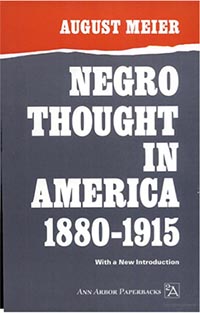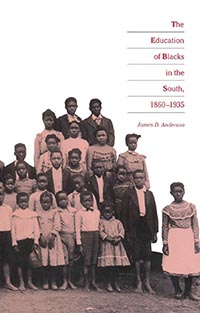Historiography
Economic Security
August Meier has argued that the African American community tended to focus more on the economic well being of the community and less on the acquisition of political power when the larger community abandons the fight for civil rights. Meier argues that African Americans began to place more

Published 1966, 1988
Ann Arbor MI
University of Michigan Press.
emphasis upon economic development and less on political action following the Reconstruction period. Considering that after Reconstruction there was an increasingly hostile backlash against the African American’s perceived gains due to the “abuses” of the Radical governments, and when we consider the lack of an equalitarian sentiment among the majority of northerners, this intellectual shift may have been a necessary reaction by the black community to save as much power as they could without raising anymore resentments from their southern neighbors. In fact, the apathetic reaction of some of the most stalwart Radical Republicans gave many blacks the realization that they were going to have to make it on their own. This phenomenon was a direct factor in the construction of an African American nationalism within the social confines of white America. We must remember that this period of time in the South was very precarious for African Americans. Joel Williamson has called this period the age of “Radical Racism” because of the astronomical increase in the numbers of lynchings and violence towards blacks. Violence and intimidation had been used as a tool by whites to enforce the racial norms and the rules of the social hierarchy in the South for many years. This type of social control was perceived as an imperative necessity by whites after the Civil War with the advent of Reconstruction and the growing status of Blacks. Although Virginia did not have as big of a problem as many other states, the Klan and other vigilante organizations did exist and they became increasingly powerful in the early twentieth century.
Trinity of Power
James Anderson's work is the touchstone for current historians to understand the complexity of this issue.
Anderson sees an environment where people were contesting the sociological meaning and structure of race. Contestation occurred between the ideas expressed by B.T. Washington and W.E.B. Dubois. 
Published 1988
Chapel Hill,NC:
University of North Carolina Press.
Anderson has added a further layer to the traditional debate by identifying the existance of a trinity of power consisting of Southern white leaders, Northern philanthropists, and the local African-American community. This three way power struggle resulted in different outcomes at different times but ultimately it seems that an alliance was formed between the Southern leadership and the northern philanthropists. This alliance was based on a sense of commonality against the Black community in terms of their general racist ideas. This racism ranged in varying degrees ranging from “moderate” to rabid racists. In other words, education was not a democratizing function for society but it was a means to establish social control and to disperse the cultural values and norms of the dominant forces in society upon the African American community.
Manassas Industrial School in Context
This school exhibits characteristics of both of these notions. It certainly was an example of the self-help institution that Meier and others point to, but it was also a facility that exhibited a form of subversiveness towards the ultimate aims of the dominant white community at large my research focuses on examine how the Manassas Industrial School exhibits the characteristics described by Meier with the notions of self-help and the pursuit of an African American consciousness. However, the Manassas Industrial School is also a useful example of how the black community was dependent upon the resources and support of white members of their own community as well as the philanthropic support of progressive minded northerners.
The African American community in Manassas acted in a dual mode which put on one face for their white supporters while exhibiting actions within their curriculum and instructional goals that contradicted this. We need to view the MIS as a school that is notably different from the traditional schools that are used to exemplify this debate. So much so that it does not fit securely into either category. For this reason the practices at Manassas may lead us to consider the possibility that there should be a space added within the historiography for a third type of industrial school. This is a school that was divided in its consciousness and unsure of its purpose beyond a basic level of education. This division resulted in a conflict between the historical actors and as a result people remain conflicted over the memory of the school today.
